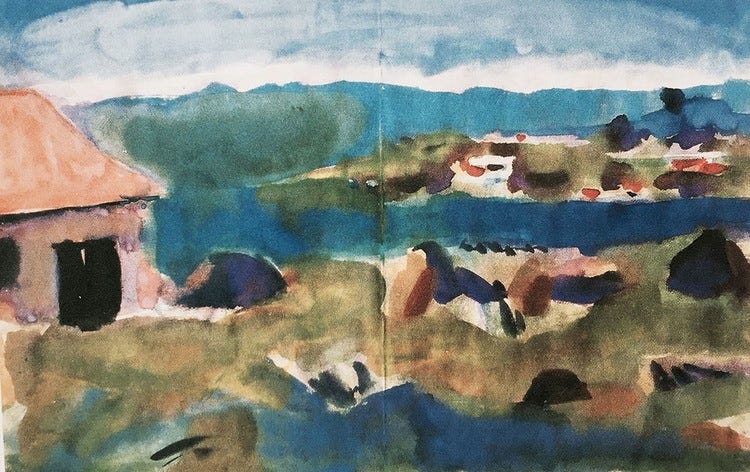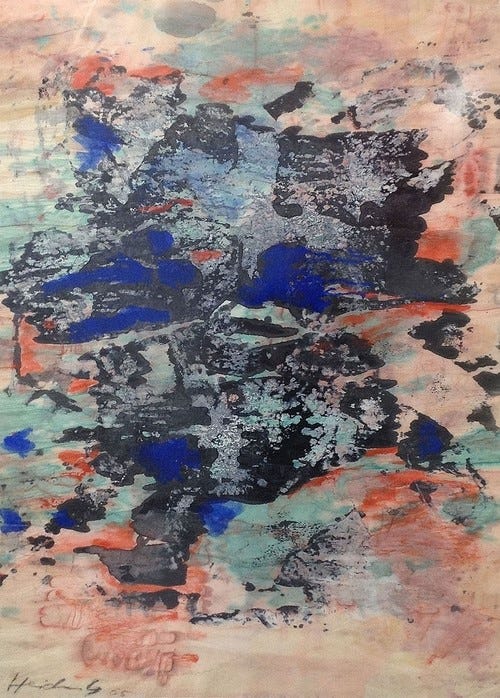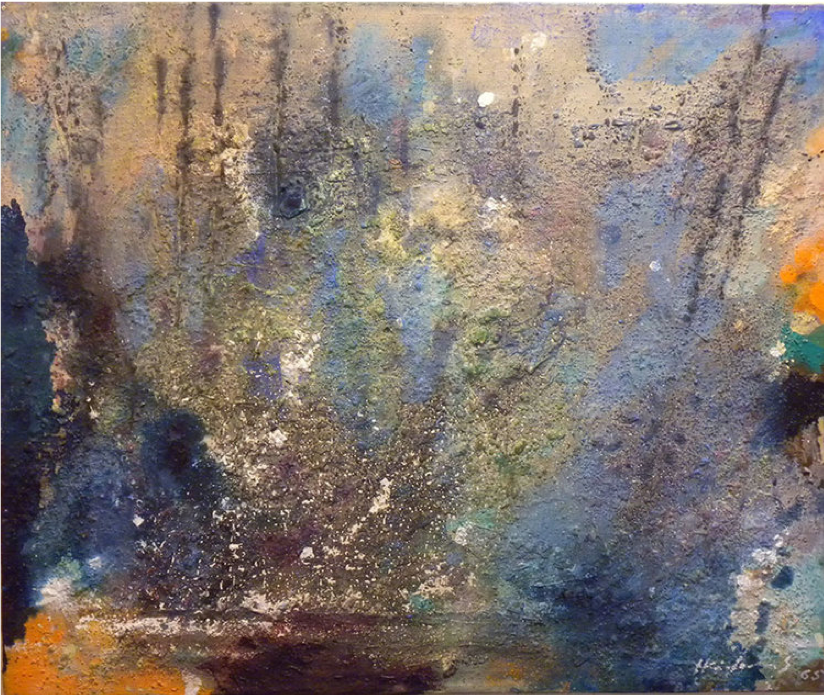The story of painter Carl Heidenreich (1901–1965) sounds familiar, even if his name and work are not. Born in the Bavarian spa town Bad Berneck im Fichtelgebirge, Heidenreich studied at the Academy of Fine Arts, Munich before becoming a student of the abstract painter and later “grand master of the New York School”[i] Hans Hofmann (1880–1966). In 1922, Heidenreich moved to Berlin, becoming a scene painter at UFA film studios, Babelsberg, where legendary Austrian director Fritz Lang shot Die Nibelungen (1924), Metropolis (1927), and Spione (1928).
Heidenreich had a solo show at Galerie Lüders, Hamburg (1927) and participated in exhibitions at the Berlin Secession and Berlin Academy of Arts (1930–33). Upon the Nazis’ rise to power, however, Heidenreich was labelled a “degenerate artist.” This was not so much for the content of his work, though it was deeply rooted in German Expressionism, as for his anti-fascist activism and membership of the German Communist Party (KPD). The Nazis cancelled his planned breakthrough solo exhibition at Galerie Niedendorf, Berlin, ransacked his studio, destroyed two hundred works, and imprisoned him in the Gestapo detention centre at Moabit Prison.Heidenreich left for France after his release in 1934, leaving behind three hundred more paintings, all destroyed by Allied bombing ten years later. Moabit was not Heidenreich’s only imprisonment by a fascist regime. He would fight for the Republicans in the Spanish Civil War in the International Brigades of the Workers’ Party of Marxist Unification (POUM), under whom George Orwell fought.[ii] In 1938, Heidenreich was captured, incarcerated, and tortured at Modelo prison, Barcelona. He depicted the grinning prison guards and downcast, gloomy prisoners tramping through the corridors in Modelo Prison (1938) and his watercolours Prison Sketch (after 1938).
After the Spanish Civil War, Heidenreich returned to Paris, staying until the outbreak of the Second World War. Then he escaped to the United States via Marseille, Casablanca, and Martinique, where he produced a number of watercolours. Martinique (1941) depicts a paradisiacal quiet that cannot conceal the deep, lonely sadness of exile.
Heidenreich eventually settled in New York with the German and German-Jewish refugee intellectuals. Among them were a circle calling themselves Das Dorf (“the village”) comprising journalist and publicist Charlotte Beradt, Yiddish writer and cultural activist Chanan Klenbort (Hanan J. Ayalti), writer Charlotte Sempell Klenbort, fellow anti-Stalinist veteran Heinrich Blücher, and Hannah Arendt, who wrote a catalogue text for Heidenreich’s retrospectives in Frankfurt (1964) and Goethe House, New York (1972).[iii] Arendt’s brief text draws on Heidenreich’s experience of exile and statelessness, relation to the tradition of German art, and the unashamed beauty of his painting, especially his later work.

Carl Heidenreich, Martinique (1941). Watercolor. Image courtesy of The Carl Heidenreich Foundation
Heidenreich was, Arendt writes, made homeless by “the same fate that made modern German art homeless.”[iv] Like Arendt, exile from Nazi Germany made Heidenreich stateless, living “outside normal legal protection”[v] and struggling to rebuild a life in America, faced with mounting losses:
We lost our home, which means the familiarity of daily life. We lost our occupation, which means the confidence that we are of some use in this world. We lost our language, which means the naturalness of reactions, the simplicity of gestures, the unaffected expression of feelings. We left our relatives in the Polish ghettos and our best friends have been killed in concentration camps, and that means the rupture of our private lives.[vi]Heidenreich shared these losses. He was also a victim of Nazi cultural policy: a total war on the German imagination and visual language. Alfred Rosenberg, the Nazis’ leading spokesman on art and culture, reviled the spiritually syphilitic “mongrel art” of Impressionism and the “abortion” that was Expressionism.[vii] Hitler himself promised to “wage an unrelenting war of purification against the last elements of putrefaction in [German, “Aryan”] culture,” including Cubism, Dadaism, Futurism, and Impressionism, which he called “the artifactitious stammerings of men to whom God has denied the race of a truly artistic talent, and in its place has awarded them the gift of jabbering or deception.”[viii]
Alla Efimova, Executive Director of The Carl Heidenreich Foundation, which aims to preserve the painter’s work and broaden its critical and historical recognition, explains that Heidenreich’s art is a story of someone who lost everything, his family, possessions, and art, “struggling to replace and recuperate his loss” by working through the traumatic experience of immigration.[ix]
The puzzle, Efimova writes, is that Heidenreich’s late works “do not fit into any accepted narrative of twentieth century modernism.” Richard M. Buxbaum, President of the Foundation’s Board of Trustees likewise argues that the strength of the work means it “should be part of a canon.”[x] One answer is to position Heidenreich in relation his teacher, the great Hans Hofmann.

Carl Heidenreich, Landscape in Red and Blue (1965). Watercolor. Image courtesy The Carl Heidenreich Foundation
Hofmann was the only artist of the New York School — the city’s experimental poets, painters, dancers, and musicians working in the 1950s-60s — to participate directly in the early-20th century avant-garde.
Hofmann would tell students at his forward-thinking private academies in Munich (1914–32), New York (1934–58), and Provincetown, Massachusetts (1935–58) stories about his time in Paris (1904–14); of his exposure Cubism, Fauvism, and Futurism as they happened; of nights at Café du Dôme with Picasso, Braque, Rouault, Pascin, Léger, and Picabia; of drawing classes attended with Matisse at the Ecole de la Grande Chaumière. Hofmann’s development, students (all far better known than Heidenreich), and reputation, are, however, less important for us than his influential theories of painting and their influence on Heidenreich.[xi]
Arendt argues that, despite spending thirty years outside Germany, Heidenreich was still a “specifically German painter.”[xii] Heidenreich preserved, Arendt claims, a quality of “intense inwardness.” This English expression fails to describe, let alone define, the German Immigkeit. Heidenreich’s Immigkeit is comparable, for Arendt, not only to the great lyric poets, but a whole German artistic tradition including Caspar David Friedrich, Lovis Corinth, and Emil Nolde. She sees Heidenreich’s loyalty to their inspiration, if not the tradition for its own sake.
Hofmann believed in a version of Immigkeit, too. In a late interview, he explains his belief in the “spiritual” quality of artistic creation. This is, for Hofmann, not a syncretic “new age” faith, but comparable to the German Geistigkeit. Hofmann thus places himself in the tradition of Spinoza, Schiller, and Goethe, frequently quoted in his lectures. This is, he explains, is a result of a sixth sense, the sense of sensibility, the ability to see or look into things in depth, to discover the inner life. We see only the surface of things, but our sensibility explores the inner life of everything and has the capacity to feel every new relationship to this inner life.[xiii]
Hofmann’s main interest was how artists translate their own experiences into works of art which reflect the “sensorial and emotional world” according to the “inner laws” of a specific medium.[xiv] Artists, for Hofmann, must not imitate nature, but transform the external physical reality into spiritual reality, reordering of their experience of nature in the physical form of a work of art, in which “the spiritual quality dominates the material.”[xv]
Arendt explains sensus communis (“common sense”) in similar terms. She explains that things appear to us in two modes. We take in the world through our five senses (sight, smell, touch, taste, and hearing). This gives our experiences of things the character of seeming. The world seems to us to be one way or another based on our subjective, personal take on it. Appearances also carry what Arendt calls “a prior indication of realness.”[xvi] This is sensus communis, a “sixth sense,” an idea which enters western philosophy through Thomas Aquinas, for whom this “inner sense” unifies all objects of the five senses, guaranteeing that the thing we see, touch, taste, smell, and hear is one and the same object.[xvii]
There is no body part for sensus communis, Arendt explains.[xviii] It has no dedicated receptive organ like eyes for seeing and ears for hearing. The five senses are, indeed, entirely private, sealed off from the rest of the world. Their corresponding sensations cannot be felt by or directly communication to anyone else because I see things with my eyes, feel with the touch of my skin, taste with my tongue, smell with the odors in my nose, hear the sound in my ears.
Sensus communis, however, lets us translate private sensations into a common language shared by others. Its worldly property is, Arendt explains, “realness.” There is a problem with this, however. Because we cannot perceive it like other primary sensory qualities, the sensus communis is not itself a sensation because, Arendt says, “the ‘sensation’ of reality, of sheer thereness, relates to the context in which single objects appear as well as to the context in which we ourselves as appearances exist among other appearing creatures.”[xix]

Carl Heidenreich, Untitled (1965). Oil. Image courtesy of Richard M. Buxbaum
Efimova says that Heidenreich “absorbed Hofmann’s teaching, and into his mature years continued to assert principles of abstraction first learned in the Munich school.” Despite his personal convictions, there is little political content in Heidenreich’s painting, just as Hofmann’s painting was apolitical. Rather, as Arendt points out, Heidenreich’s work mainly consists of landscapes, scenes from his travels through Spain, France, Mexico, Alaska, and the Pacific, and New York cityscapes. Arendt owned four of these works, Figure (1949), Midtown (1953), Alaska I (1961), and Orpheus (1962), lending them to the 1964 and 1972 retrospectives.
Following his move towards abstraction in the 1940s-50s, Heidenreich’s best work is from the 1960s. Many of these paintings are in the collection of Richard Buxbaum, but there were thousands in Heidenreich’s studio when he died. Much time could be spent poring over every swoop of Heidenreich’s hand, every elusive dusting of paint. Perhaps none of these works are more delicate or evocative than Untitled (1965), which now graces the cover of the Arendt’s posthumously published collection Reflections on Literature and Culture.
The central motif in Untitled, which looks like a verdant organic growth, is doubly closed in by touches of orange and swathes of deep azure. The orange and sprays of white are like light apprehended at the corner of our visual field as it ricochets from reflective surfaces — the glass, steel, and oily puddles of the modern city, or mingled memories of different seas and skies, at home or in exile.
Untitled is not a conventional landscape, however. Though you can see oceanic azure in it, it doesn’t refer to any specific daybreak or twilight. There is no precise geography, as in the paintings of Martinique or Alaska. It is, rather, an attempt to render otherwise incommunicable feelings about the world into something visible and shareable by others. This can only be achieved, following Hofmann’s teachings, by abstracting from any and every definite point of visual reference or position in real space.
Arendt says that producing a liveable world involves, in part, “the transformation of the intangible into the tangibility of things.”[xx] To become part of a shared world, the things we do or think must be felt, remembered, and turned into things that other people can see, hear, and remember (stories, poems, paintings, sculptures). Untitled, like so many of Heidenreich’s paintings, contains no acting bodies or objects for use. It is, however, based on the deep conviction that our feelings about and experiences of the world are memorable in their own right and worthy of sharing. Heidenreich’s task is to translate them into something for all of us to see and feel, even as all that is solid melts into air and the loss of the old country and its ways recedes beyond the horizon of memory. Indeed, Arendt writes that Heidenreich’s work develops “out of the basic colors as they are characteristic and conspicuous in the various parts of the world. The ability to see and represent these basic elements, the fundamental chord, as it were, with all its modulations, is manifest in every picture.”[xxi]
Heidenreich was never fashionable and has mostly been forgotten. He is unlikely to become fashionable any time soon. The contemporary art world rejects theories of spiritual insight like Hofmann’s and derides the very idea that beauty is something worthy of thought. Even if he never becomes fashionable again, and his legacy is drowned out by louder voices, he deserves to be remembered as his friends from Das Dorf recall him: not just the rebellious, even reckless risk-taker but a quiet, sensitive man, loved by his friends. Arendt captures this when she writes that “The friends of Carl Heidenreich’s paintings know how marvellous it is to live with them and that as they hang on one’s walls they become ever more beautiful.”[xxii] We can take two things away from this: not just the unashamed belief in the transformative power of beauty, and not just that the painter Carl Heidenreich had friends, but that his paintings had friends that will outlive even them, returning the gaze of new viewers who make them a part of their world.
